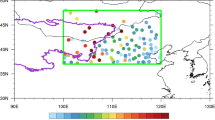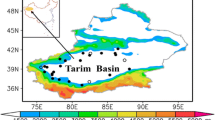Abstract
The link between winter sea ice cover in the Barents Sea (SICBS) and the frequency of spring dust weather over North China (DWFNC) is investigated. It is found that year-to-year variability of SICBS and DWFNC are strongly correlated for the period 1996–2014 with a correlation coefficient of −0.65, whereas the correlation between SICBS and DWFNC is not statistically significant for the periods 1980–2014 and 1980–1995. During 1996–2014, low winter SICBS is associated with decreased snow cover over western Siberia (SCWS) in both winter and spring, which is also supported by a strengthening relationship between winter SICBS and spring SCWS since the mid-1990s. This leads to changes in atmospheric circulation and climate conditions that are favorable for increased frequency of dust weather events over North China. Our further analysis suggests that the interannual variability of the standard deviation of SICBS has intensified and the center of actions has moved eastward to the north Barents Sea and Kara Sea since the mid-1990s. Such change may easily induce stronger and southward stationary Rossby wave train propagation, influencing the dust-related atmospheric circulation (strengthened East Asian subtropical jet, increased cyclogenesis, and larger atmospheric thermal instability). Thus interannual variation of winter SICBS plays an increasingly important role in dust-related climate conditions over North China, which might serve as a new precursor for the prediction of spring dust activity in North China.








Similar content being viewed by others
References
Archer CL, Calderia K (2008) Historial trends in the jet streams. Geophys Res Lett 30:L08803. doi:10/1029/2008GL033614
Barenett TP, Dumenil L, Schlese U, Roekler E, Latif M (1989) The effect of Eurasian snow cover on regional and global climate variation. J Atmos Sci 46:661–686
Cohen J, Coauthors (2014) Recent Arctic amplification and extreme mid-latitude Weather. Nat Geosci 7:627–637
Cohen J, Entekhbabi D (1999) Eurasian snow cover and Northern Hemisphere climate predictability Geophys Res Lett 26(3):345–348
Comiso JC, Parkinson CL, Gersten R, and Stock L (2008) Accelerated decline in the Arctic sea ice cover. Geophys Res Lett 35:L01703. doi:10.1029/2007GL031972
Deser C, Teng H (2008) Evolution of Arctic sea ice concentration trends and the role of atmospheric circulation forcing during 1979–2007. Geophys Res Lett 35:L02504. doi:10.1029/2007GL032023
Fan K and Wang HJ (2004) Antarctic Oscillation and the dust weather frequency in North China. Geophysics Res Lett 31:L10201. doi:10.1029/2004GL019465.
Fan K, Wang HJ (2006) The interannual variability of dust weather frequency in Beijing and its global atmospheric circulation. Chin J Geophys 49:890–897
Fan K and Wang HJ (2007a) Dust storms in North China in 2002: a case study of the low frequency oscillation. Adv Atmos Sci 24(1):15–23
Fan K, Wang HJ (2007b) Simulation on the AAO anomaly and its influence on the Northern Hemispheric circulation in boreal winter and spring. Chin J Geophys 50(2):397–403
Fan K, Xie ZM, Xu ZQ (2016) Two different periods of high dust weather frequency in northern China, 016 Vol. 9 (4):263–269. doi:10.1080/16742834.2016.1176300
Francis J, Vavrus S (2012) Evidence linking Arctic amplification to extreme weather in mid-latitudes. Geophys Res Lett 39:L06801
Gao YQ, Sun JQ, Li F, et al. (2015) Arctic Sea ice and Eurasian Climate: a review. Adv Atmos Sci 32:92–114
Gong DY, Mao R, Shi PJ et al (2007) Correlation between east Asian dust storm frequency and PNA. Geophys Res Lett 34:L14710. doi:10.1029/2007GL029944
Graversen (2006) Do changes in the midlatitude circulation have any impact on the Arctic surface air temperature trend?. J Clim 19:5422–5438
Graversen G, Mauritsen T, Tjernström M et al (2008) Vertical structure of recent Arctic warming. Nature 451:53–56
Inoue J, Hori M (2012) The role of Barents Sea ice in the wintertime cyclone Track and emergence of a warm-Arctic and cold-Siberian Anomaly. J Clim 25:2561–2568
Kalnay E, Coauthors (1996) The NCEP/NCAR 40-year reanalysis project. Bull Am Meteorol Soc 77:437–471
Kang DJ, Wang HJ (2005) Analysis on the decadal scale variation of the dust storm in North China. Science in China (series D) (in Chinese) 35 (11):1096–1102
Kurosaki Y, Mikami M (2003) Recent frequent dust events and their relation to surface wind in East Asia. Geophys Res Lett 30:1736. doi:10.1029/2003GL017261
Lang XM (2008) Prediction model for spring dust weather frequency in North China. Sci China (series D) 51:709–720
Lee S (2014) A theory for polar amplification from a general circulation perspective. Asia-Pac J Atmos Sci 50:31–43
Liu JP, Curry JA, Wang HJ et al (2012) Impact of declining Arctic sea ice on winter snowfall. Proc Natl Acad Sci USA 109:4074–4079
Miles MW, Divine DV, Furevik T, Jansen E, Moros M, Ogilvie AEJ (2013) A signal of persistent Atlantic multidecadal variability in Arctic sea ice. Geophy Res Lett. doi:10.1002/2013GL058084
Park D, Lee S, Feldstein M (2015) Attribution of the recent winter sea ice decline over the Atlantic sector of the Arctic Ocean*. J Clim 28:4027–4033
Petoukhov and Semenov V (2010) A link between reduced Berents-Kara sea ice and cold winter extremes over northern continents. J Geophy Res 115:D21111. doi:10.1029/2009Jd013568
Qian WH, Quan LS, Shao SY (2002) Variations of the dust storm in China and its climatic control. J Clim 15:1216–1229
Robinson DA, Dewey KF, Heim R (1993) Global snow cover monitoring: an update. Bull Am Meteorol Soc 74:1689–1696
Salil M, Zhang R, Delworth TL (2011) Impact of the Atlantic Meridional overturning circulation (AMOC) on Arctic surface air temperature and sea ice variability. J Clim 24:6573–6581
Stroeve JM, Holland M, Meier W, et al. (2007) Arctic sea ice decline: faster than forecast. Geophys Re Lett 34:L109501. doi:10.1029/2007GL029703
Takaya K, Nakamura H (2001) A formulation of a phase-independent wave-activity flux for stationary and migratory quasigeostrophic eddies on a zonally varying basic flow. J Atmo Sci 58(6):608–627
Uccellini LW (1986) The possible influence of upstream upper-Level Baroclinic Processes on the development of the AEII storm. Mon Weather Rev 114:1019–1026
Wang HJ, HP Chen, Liu JP (2015) Arctic Sea ice decline intensified haze pollution in eastern China. Atmos Ocean Sci Lett 8:1–9
Wu RG, Kirtman BP (2007) Observed relationship of spring and summer East Asian rainfall with winter and Spring Eurasian snow. J Climate 20:1285–1304
Wu BY, Huang RH, Gao DY (1999) The impacts of the variation of the se-ice extend in the Kara Sea and Barents Sea in the winter on the winter Monsoon over east Asia (in Chinese). Chinses. J Atmos Sci 23:268–275
Wu YF, Zhang RJ, Han ZW, et al. (2010) Relationship between East Asian monsoon and dust weather frequency over Beijing. Adv Atmos Sci 27:1389–1398
Yang S, Lau KM, Kim KM (2002) Variations of the East Asian jet stream and Asian-Pacific- American winter climate winter climate anomalies. J Clim 15:306–325
Zhang RJ, Han ZW, Wang MX et al. (2002) Dust storm weather in China: new characteristics and origins (in Chinese). Quat Sci 22:374–380
Zhao CS Dabu X, Li Y (2004) Relationship between Climatic factors and dust storm frequency in Inner Mongolia of China. Geophys Res Lett 31:L01103. doi:10.1029/2003Gl018351
Zhu CW, Wang B, Qian WH (2008) Why do dust storms decrease in northern China concurrently with the recent global warming? Geophys Res Lett 35:L18702. doi:10.1029/2008GL034886
Zou XK, Zhai PM (2004) Relationship between vegetation coverage and spring dust storms over northern China. J Geophys Res Atmos 109(D3). doi:10.1029/2003JD003913
Zuo ZY, Zhang RH, Wu BY, Rong XY (2012) Decadal variability in springtime snow over Eurasia: relation with circulation and possible influence on spring time rainfall over China. Int J Climatol 32:1336–1345
Acknowledgements
The authors are grateful to Editor and the anonymous reviewers for their insightful comments. This research was jointly supported by the National Natural Science Foundation of China (Grant Nos. 41325018, 41421004, 41575079, 41676185). The research also supported by the CAS/SAFEEA International Partnership Program for creative Research Team “Regional environmental high resolution numerical simulation”.
Author information
Authors and Affiliations
Corresponding author
Rights and permissions
About this article
Cite this article
Fan, K., Xie, Z., Wang, H. et al. Frequency of spring dust weather in North China linked to sea ice variability in the Barents Sea. Clim Dyn 51, 4439–4450 (2018). https://doi.org/10.1007/s00382-016-3515-7
Received:
Accepted:
Published:
Issue Date:
DOI: https://doi.org/10.1007/s00382-016-3515-7




